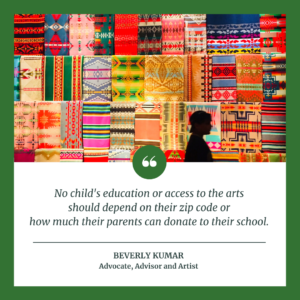
As a public school advocate and artist, of course my stance is that art education matters in educating the whole child. I hope they matter to you too. If they don’t, at the very least, I hope you’ll agree that a 12% compliance across school districts in the state of California in which it’s the law to have the arts in schools, means that we should probably be setting a better example. The law? Yes– Ed Code. Like math class. It’s the law to have math class in California schools too.

Just as much as the arts matter, funding for those art programs matter a lot too. That’s where it gets tricky. Even controversial. Definitely not equitable. Our school districts must start investing money in the arts— something that districts have side stepped for far too long. However, we can’t tip toe over this conversation anymore. After almost 18 months of traditional school being interrupted due to life in a pandemic, social emotional learning and equity have risen to the top of our priorities and at last, it’s time for the arts to take center stage. There has never been a time when our children needed the arts more in their lives.

What is Ed Code? “A collection of all the laws directly related to California K-12 public schools. Ed Code sections are created or changed by the governor and Legislature when they make laws. Local school boards and county offices of education are responsible for complying with these provisions.” (EdSource)

What does it say about Arts Education in California schools? California’s Education code promises visual art, music, dance, theater and media arts classes to each K-12 student.

Education Code Section 8811
Defines the “arts” to include the four disciplines of dance, drama and theatre, music, and visual arts as set forth in the state’s adopted curriculum framework for visual and performing arts.
Education Code Section 51210
(a) The adopted course of study for grades 1 to 6, inclusive, shall include instruction, beginning in grade 1 and continuing through grade 6, in the following areas of study … (e) Visual and performing arts, including instruction in the subjects of dance, music, theatre, and visual arts, aimed at the development of aesthetic appreciation and the skills of creative expression.
Education Code Section 51220
The adopted course of study for grades 7 to 12, inclusive, shall offer courses in the following areas of study: …
(g) Visual and performing arts, including dance, music, theatre, and visual arts, with emphasis upon development of aesthetic appreciation and the skills of creative expression.

The Problem? Even though section 51210(e) mandates the Visual and Performing Arts, long time art education advocate and teacher Carl Schafer shares with us, section 51050 states, “The governing board of every school district shall enforce in its schools the courses of study.” Therefore, no one is enforcing the law and holding school boards accountable. Carl Schafer goes on to share, “…to simply allow non-compliance with the California Education Code is unacceptable. We should teach our children that the arts matter. And so does the law.” (Carl Schafer)
The conversation we should all be having. What would it take for you to advocate to your school board that art is vital to educating the whole child? How would you feel if one day the school board said the district would no longer be teaching math or science…? We should feel no different regarding the absence of the arts in our classrooms.
Moving Forward.
Immediate response… Level the playing field with site specific Education Foundations. While these organizations are separate entities from the school district, school boards have a duty, which cannot be delegated to any citizen or group of citizens, to govern, manage and control the business of the district and the interests of its schools. While some schools receive a lot of money through parent donations, the reality is that many do not. We need a framework of “basics,” if you will, which ensures that all elementary schools (to start with) include investing in the arts by hiring art teachers. This will also address the topic of inequity. Currently, in our school district, these are all parent funded positions by money the district is gifted through Education Foundations- which it then hires for school sites. Often it’s a volunteer that likes to teach art but lacks certification, training or an understanding of the California Arts Curriculum.
Long term goal… Give every subject a line item allocation in the district budget. Transition from classified staff to certified staff for art teachers. Push the California Department of Education to re-evaluate it’s stance on enforcement linked to an equity issue. Create a formal complaint procedure process for teachers, parents and students to hold school boards accountable when need be.
What can you do right now? Many districts across the state of California are working on their strategic plan — plus! They have received federal and state Covid-19 relief money, some of which is to be used at their discretion. This presents an opportunity for you to reach out to your school board members and advocate for the arts. Align your thoughts with the goals in the strategic plan or mission of the school district. Ask your district to adopt a Declaration of Arts Education in Learning just like West Contra Costa’s Board of Education and school district did. You can find the complete document here.

Reach out to an art teacher in support and help facilitate the conversation about the arts in your area. Create opportunities for partnerships and be open to creative ideas that show promise not just for your child’s school, but for all of our California kids. Take it up a level and contact your state officials and ask them about Ed Codes, policy, enforcement and more funding for schools. When you factor in that if California were a country, it would be the 5th largest economy in the world and we rank near the bottom for funding for education, we owe it to all our California kids to do better.

Resources
- California’s Education code promises visual art, music, dance, theater and media arts classes to each K-12 student, but only 12% of our schools are in compliance with that mandate. Source: Create California
- 89% of California K-12 schools fail to offer a standards-based course of study in all four disciplines—music, visual arts, theatre, and dance—and thus fall short of state goals for arts education. Source: Americans For The Arts
- Find out how much California school districts and charter schools will get in Covid relief: EdSource
- To read more about the California Arts framework and standards: California Department of Education
- How to find your California Legislator: CA Gov
- Researchers are finding that foundations, set up to raise money for public schools, are reintroducing funding inequality that was supposed to be eliminated back in the 1970s, when the California Supreme Court ruled on the Serrano vs. Priest case. Source: KPCC
- Thus LEFs (Local Education Foundations) are adding inequality into an education finance system whose 1970s reforms were designed to promote equality and break the connection between wealth and education outcomes. Source: California Local Education Foundations
- State-by-State Guide for Arts Education Funding
































 Online, or rather Distance Learning for our kids this year means two super important items were added to personal our back-to-school supply list; Blue Blocking Glasses and a 64 ounce water bottle.
Online, or rather Distance Learning for our kids this year means two super important items were added to personal our back-to-school supply list; Blue Blocking Glasses and a 64 ounce water bottle.